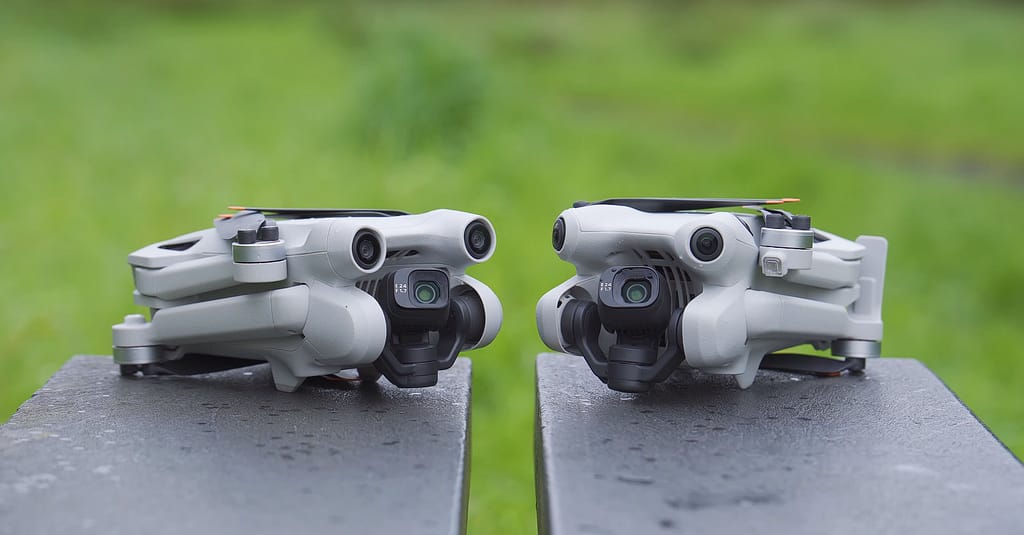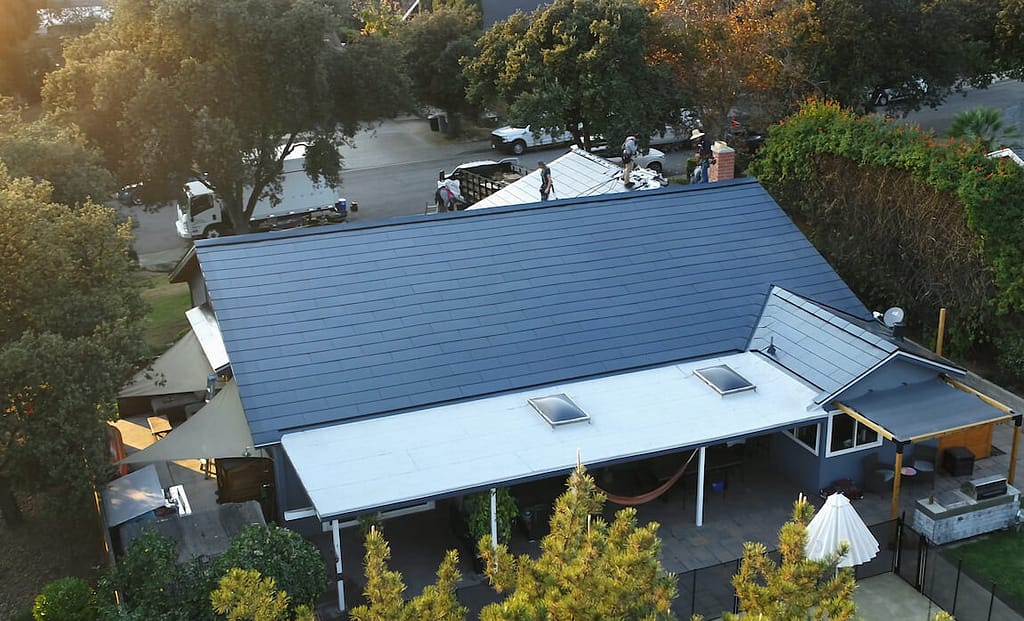This article will provide the major difference between DJI Mini 4 Pro and Mini 3 Pro to help you find out the Best in use for you.
DJI has recently launched the Mini 4 Pro, the latest addition to its renowned Mini series of drones. For those familiar with the Mini series, these drones have garnered a loyal following due to their versatility, portability, and compliance with aviation regulations. With the Mini 4 Pro, DJI has not only addressed the shortcomings of its predecessor, the Mini 3 Pro but has also incorporated a slew of new features that make it a compelling choice for drone enthusiasts. In this article, we will delve into the extensive list of upgrades and enhancements found in the Mini 4 Pro, comparing them to the Mini 3 Pro.
Differences between the DJI Mini 4 Pro and Mini 3 Pro
| Feature | DJI Mini 4 Pro | DJI Mini 3 Pro |
|---|---|---|
| Design and Build | Redesigned gimbal and propeller guards, improved protection for sensors, similar weight and size. | Older gimbal guard design, no propeller guard included. |
| Flight Time | 45 minutes (with standard battery), 34 minutes (with optional battery). | 47 minutes (with optional battery). |
| Obstacle Avoidance | Four new fisheye sensors for omnidirectional obstacle avoidance, APAS feature for automatic obstacle navigation. | Tri-directional obstacle avoidance. |
| Camera Upgrades | Improved low-light performance, HDR video at up to 60 FPS, 4K at 100 FPS for slow motion, expanded color profiles, vertical recording capability, Next-Gen SmartPhoto for enhanced photography. | Limited HDR video at 30 FPS or lower, 4K at 60 FPS for slow motion, fewer color profiles, no vertical recording. |
| Advanced Tracking Features | Active Track 360 for customizable tracking, omnidirectional obstacle avoidance during tracking. | Basic tracking options. |
| Enhanced Transmission | AugSync 4 for 1080p at 60 FPS live view, 20 kilometers FCC range. | 12 kilometers FCC range. |
| Additional Features | Active Track 360 for customizable tracking, and omnidirectional obstacle avoidance during tracking. | Limited additional features. |
| Regulation-Friendly Design | “C0” marking for compliance with European and U.S. regulations. | Compliance with regulations but not specified. |
The DJI Mini 4 Pro offers significant improvements in obstacle avoidance, camera capabilities, tracking features, transmission range, and additional functionalities compared to the Mini 3 Pro. It also maintains a regulation-friendly design, making it an attractive option for drone enthusiasts.
Design and Build
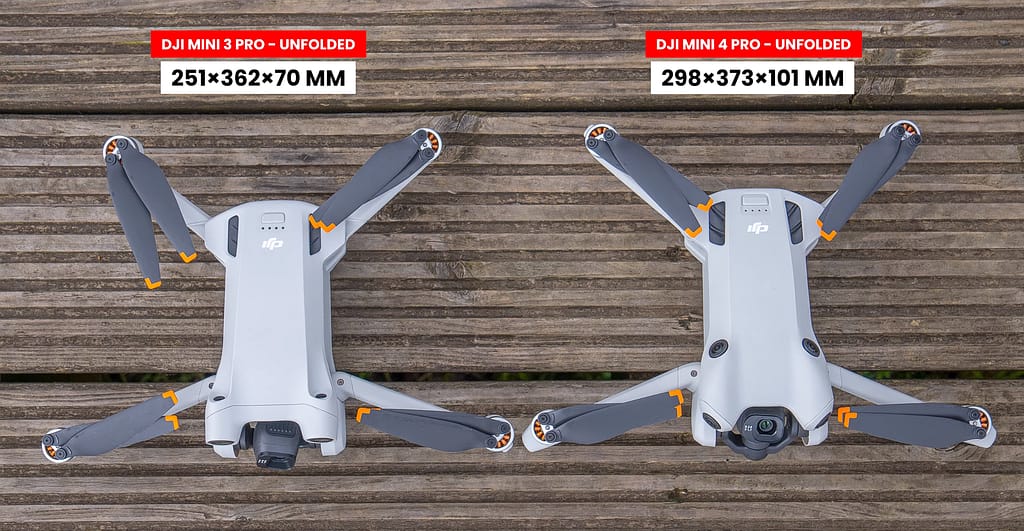
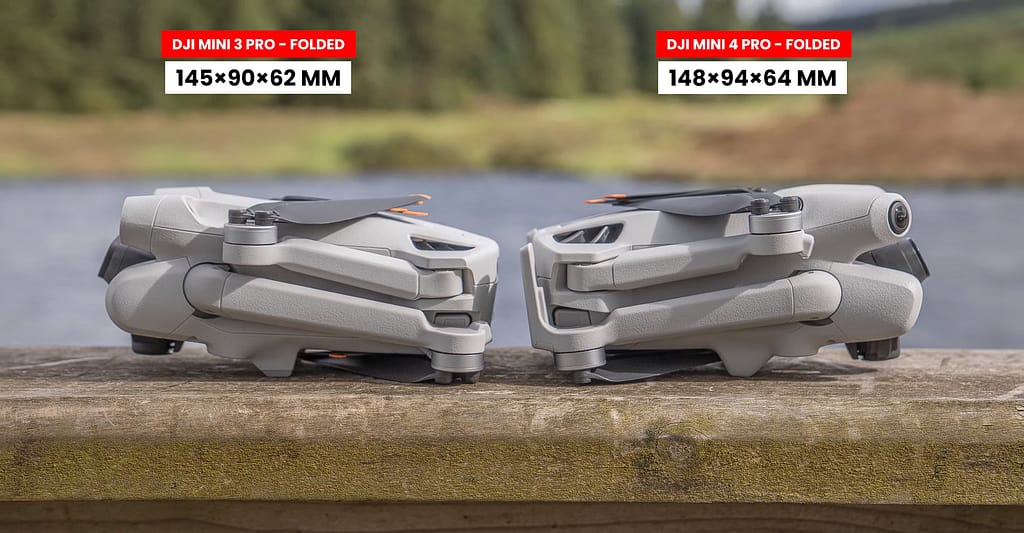
Upon unboxing the Mini 4 Pro, one immediately notices the inclusion of a propeller guard and a new gimbal guard. The redesigned gimbal guard is a welcome improvement over the Mini 3 Pro, making installation a breeze. It not only shields the gimbal and camera but also protects the two front-facing fresh-eye sensors, a crucial feature for obstacle avoidance. Additionally, a new propeller guard is now included with the drone, adding stability when the drone is set down and preventing the accumulation of debris on the sensors.
In terms of size and weight, both the Mini 4 Pro and Mini 3 Pro maintain their lightweight and portable profiles, weighing under 249 grams. Flight time remains consistent at 34 minutes, with the Mini 3 Pro edging slightly ahead with an optional flight battery that provides 47 minutes compared to the Mini 4 Pro’s 45 minutes. This variance could be attributed to the additional sensors on the Mini 4 Pro, which may consume more battery power.
Obstacle Avoidance
One of the standout upgrades in the Mini 4 Pro is its enhanced obstacle avoidance system. It boasts four new fisheye sensors, two facing forward and two facing backward, in addition to downward binocular vision sensors and infrared sensors. This comprehensive array enables omnidirectional obstacle avoidance, a substantial improvement over the Mini 3 Pro’s tri-directional obstacle avoidance. The Mini 4 Pro’s ability to detect obstacles in all directions, including sideways, greatly enhances safety during tracking and intelligent flight modes, making it an ideal choice for beginners.
Moreover, the Mini 4 Pro introduces the Advanced Pilot Assessing System (APAS), which includes a bypass mode. This feature allows the drone to sense obstacles in its flight path and automatically navigate around them without requiring additional inputs from the controller. It’s a valuable addition to maintaining smooth and safe flights, especially in challenging environments.
Camera Upgrades
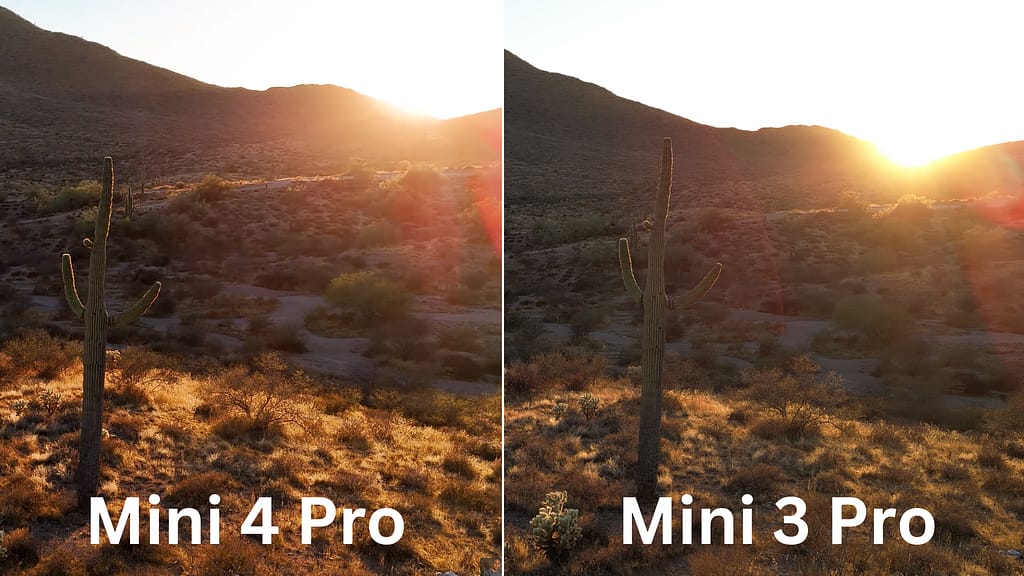
The camera on the Mini 4 Pro retains the 1/1.3-inch sensor and f/1.7 aperture found in the Mini 3 Pro. However, thanks to an updated image signal processor, the Mini 4 Pro offers improved performance in low-light conditions and reduced blurriness when using higher ISO settings. Notably, the Mini 4 Pro supports HDR video at up to 60 FPS in 4K, a significant improvement over the Mini 3 Pro’s limitation to 30 FPS or lower for HDR. Additionally, the Mini 4 Pro excels in slow-motion capabilities, offering 4K at 100 FPS compared to the Mini 3 Pro’s 4K at 60 FPS. It also offers 1080P recording at an impressive 200 FPS.
The color profile options have expanded on the Mini 4 Pro, with the addition of D-Log and HLG alongside the existing Sunny-Like profile. These additions provide more flexibility for post-processing and color grading, allowing users to retain more highlight and shadow details. Furthermore, the Mini 4 Pro’s camera can rotate, enabling vertical recording, which is particularly useful for social media platforms like Instagram.
For photography enthusiasts, the Mini 4 Pro introduces Next-Gen SmartPhoto, which automatically selects different stack methods like HDR or HyperLight to optimize image parameters based on the scene being captured. This results in images with a higher dynamic range, with an impressive increase of up to five stops. The Mini 4 Pro offers the choice between capturing 12-megapixel and 48-megapixel images, and the image quality has been praised for its breathtaking visuals.
Advanced Tracking Features
DJI has revamped its tracking modes in the Mini 4 Pro. While the Mini 3 Pro offered basic tracking options, the Mini 4 Pro introduced Active Track 360, one of DJI’s most advanced tracking modes. This feature allows users to customize the orientation and distance from which the drone tracks its subject. The controller’s screen displays a dial where users can select the drone’s orientation and distance preferences. This customization opens up new possibilities for creating diverse tracking shots. The Mini 4 Pro’s omnidirectional obstacle avoidance system adds an extra layer of safety during tracking, as the drone can detect obstacles from all directions.
Enhanced Transmission
The Mini 4 Pro offers two controller options: the DJ RC2 with a built-in screen and the DJ RC that accommodates a smartphone. Both controllers feature an upgraded antenna system that enables the use of AugSync 4 with the Mini 4 Pro. This upgrade results in a live view on the controller screen at 1080p and 60 FPS, along with a remarkable transmission distance of 20 kilometers FCC. This marks a significant improvement over the Mini 3 Pro’s range of 12 kilometers FCC. While these extended distances may not be necessary for most users, AugSync 4 shines in scenarios where the drone briefly loses signal, ensuring a stable and reliable connection.
Additional Features
The Mini 4 Pro introduces several new features and improvements to enhance the user experience. These include:
- Waypoints: DJI has answered user requests by adding waypoints to the Mini 4 Pro’s capabilities. Users can create pre-planned flight routes and specify actions at each waypoint. This feature is particularly useful for capturing progress videos or showcasing seasonal changes.
- Cruise Control: A new cruise control mode simplifies the process of executing smooth and consistent drone moves. Users can lock in a drone movement, allowing for steady footage without the risk of unintended jerky movements.
- Advanced Return to Home: The Mini 4 Pro offers an advanced return-to-home mode that calculates the ideal altitude for a safe return. It also allows the drone to automatically navigate around obstacles during its return, preserving battery life.
- Augmented Reality (AR) Features: The Mini 4 Pro introduces AR elements, including an AR home point, an AR flight path display, and an AR aircraft shadow. These features enhance situational awareness during flights, aiding navigation and precision landings.
- Hyperlapse Improvements: The Mini 4 Pro removes the time limit on hyper-lapse recordings and significantly speeds up hyper-lapse processing, reducing the time required to generate hyper-lapse videos.
Regulation-Friendly Design
One notable addition to the Mini 4 Pro is the “C0” marking, signifying compliance with regulations in both Europe and the United States. In Europe, no exam or training is required, and in the United States, no registration is needed. This makes the Mini 4 Pro an appealing option for those looking to navigate the complex landscape of drone regulations.
Conclusion
In summary, the DJI Mini 4 Pro builds upon the strengths of its predecessor, the Mini 3 Pro, and introduces a host of exciting features and improvements. From enhanced obstacle avoidance and tracking capabilities to camera upgrades and extended transmission range, the Mini 4 Pro offers a compelling package for both beginners and experienced drone enthusiasts. With its compact and lightweight design, the Mini 4 Pro remains a versatile and regulation-friendly choice in the world of consumer drones.

